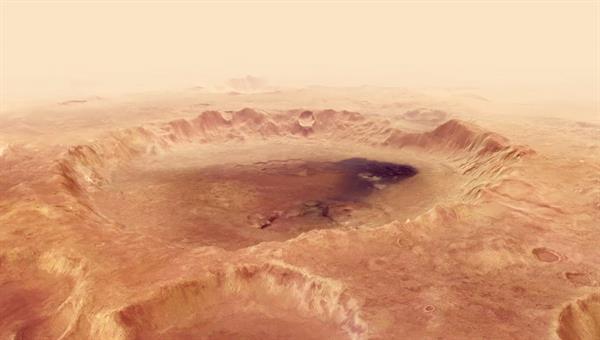Flight over Neukum Crater on Mars

Your consent to the storage of data ('cookies') is required for the playback of this video on Quickchannel.com. You can view and change your current data storage settings at any time under privacy.
ESA/DLR/FU Berlin, CC BY-SA 3.0 IGO
- The video shows a flight over Neukum Crater in the southern Martian highlands – the crater was named after the German planetary scientist Gerhard Neukum (1944-2014)
- This impact crater has a diverse geological history, dating back to approximately four billion years ago
- The age of a crater can be determined using crater size-frequency distributions, a statistical method developed by Gerhard Neukum and his colleagues in the 1970s
- Focus: Space, planetary research
This video shows a flight over the 102-kilometre wide Neukum Crater in the southern highlands of Mars. It is based on data acquired by the High Resolution Stereo Camera (HRSC), operated by the German Aerospace Center (Deutsches Zentrum für Luft- und Raumfahrt; DLR) on board the ESA Mars Express spacecraft, which has been orbiting Mars since 2003.
The impact crater was named after the German planetary scientist Gerhard Neukum (1944-2014), who led the development of the HRSC. The crater is located in the Noachis Terra region in the densely cratered Martian southern highlands, roughly 800 kilometres from the western rim of the large impact crater Hellas Planitia. Neukum Crater has a diverse geological history, as evidenced by the different geomorphological structures on the crater rim and floor.
Various events have left their mark on the crater
Over billions of years, the floor of the Neukum Crater has been filled with sedimentary deposits, resulting in a flattening of the originally bowl-shaped and much deeper crater interior. The crater rim and the materials ejected during the impact have been heavily eroded by water, wind and subsequent impacts. Glacial processes may also have occurred, as evidenced by the presence of moraine-like structures and landslides on the crater slopes.
Neukum Crater is characterised by a dark dune field and two large depressions on the crater floor. Unlike dune fields on Earth, most of those found on Mars are dark, as they consist of volcanic material. Within the dune field, the steep slopes are predominantly oriented towards the west, indicating that the prevailing wind direction was from the east at the time the dunes were formed. Also clearly visible are light-coloured deposits on the crater floor, to the west of the dune field.
Determining the age of craters on Mars
The age of Neukum Crater can be determined by the statistical distribution of the various sized craters in its interior, on the rim and on the ejecta deposits of the large crater since its formation. This special method was developed by Gerhard Neukum and his colleagues and has been widely used in the scientific community since the 1970s. If there are no samples from a particular area of a planetary surface whose age can be determined by analysing the isotopes of various chemical elements contained therein, this statistical method is a simple and reliable means of dating, especially in the case of very old formations. This crater size-frequency distribution was calibrated by assessing the age of rock samples from the Moon collected at the six landing sites during the Apollo missions and brought back to Earth. Using this method, it can be determined that Neukum Crater was formed approximately four billion years ago. The oldest sediments, located near the crater rim, were deposited approximately 3.5 to 3.7 billion years ago. Much more recent sediments in the depressions on the crater floor, with measured ages of just 66 million years, indicate geological overprinting by different processes.
Image processing and video creation
The colour image mosaic was created using data from three Mars Express orbits (2529, 4346, 4357). The data was acquired using the HRSC nadir channel, which has its field of view oriented perpendicular to the Martian surface, and the HRSC colour channels. The image covers approximately 26 to 31 degrees east and 42 to 47 degrees south. The mosaic image was then combined with topographic information from the HRSC stereo channels, creating a three-dimensional landscape. After this, views of the Martian landscape were created from different angles, similar to a film camera, and the overflight video was generated.
The HRSC experiment on Mars Express
The High Resolution Stereo Camera was developed at the German Aerospace Center (Deutsches Zentrum für Luft- und Raumfahrt; DLR) and built in collaboration with partners in industry (EADS Astrium, Lewicki Microelectronic GmbH and Jena-Optronik GmbH). The science team, which is headed by Principal Investigator (PI) Ralf Jaumann, consists of 52 co-investigators from 34 institutions and 11 countries. The camera is operated by the DLR Institute of Planetary Research in Berlin-Adlershof.
